18.7: Drugs and the Mind
- Page ID
- 153917
\( \newcommand{\vecs}[1]{\overset { \scriptstyle \rightharpoonup} {\mathbf{#1}} } \)
\( \newcommand{\vecd}[1]{\overset{-\!-\!\rightharpoonup}{\vphantom{a}\smash {#1}}} \)
\( \newcommand{\id}{\mathrm{id}}\) \( \newcommand{\Span}{\mathrm{span}}\)
( \newcommand{\kernel}{\mathrm{null}\,}\) \( \newcommand{\range}{\mathrm{range}\,}\)
\( \newcommand{\RealPart}{\mathrm{Re}}\) \( \newcommand{\ImaginaryPart}{\mathrm{Im}}\)
\( \newcommand{\Argument}{\mathrm{Arg}}\) \( \newcommand{\norm}[1]{\| #1 \|}\)
\( \newcommand{\inner}[2]{\langle #1, #2 \rangle}\)
\( \newcommand{\Span}{\mathrm{span}}\)
\( \newcommand{\id}{\mathrm{id}}\)
\( \newcommand{\Span}{\mathrm{span}}\)
\( \newcommand{\kernel}{\mathrm{null}\,}\)
\( \newcommand{\range}{\mathrm{range}\,}\)
\( \newcommand{\RealPart}{\mathrm{Re}}\)
\( \newcommand{\ImaginaryPart}{\mathrm{Im}}\)
\( \newcommand{\Argument}{\mathrm{Arg}}\)
\( \newcommand{\norm}[1]{\| #1 \|}\)
\( \newcommand{\inner}[2]{\langle #1, #2 \rangle}\)
\( \newcommand{\Span}{\mathrm{span}}\) \( \newcommand{\AA}{\unicode[.8,0]{x212B}}\)
\( \newcommand{\vectorA}[1]{\vec{#1}} % arrow\)
\( \newcommand{\vectorAt}[1]{\vec{\text{#1}}} % arrow\)
\( \newcommand{\vectorB}[1]{\overset { \scriptstyle \rightharpoonup} {\mathbf{#1}} } \)
\( \newcommand{\vectorC}[1]{\textbf{#1}} \)
\( \newcommand{\vectorD}[1]{\overrightarrow{#1}} \)
\( \newcommand{\vectorDt}[1]{\overrightarrow{\text{#1}}} \)
\( \newcommand{\vectE}[1]{\overset{-\!-\!\rightharpoonup}{\vphantom{a}\smash{\mathbf {#1}}}} \)
\( \newcommand{\vecs}[1]{\overset { \scriptstyle \rightharpoonup} {\mathbf{#1}} } \)
\( \newcommand{\vecd}[1]{\overset{-\!-\!\rightharpoonup}{\vphantom{a}\smash {#1}}} \)
\(\newcommand{\avec}{\mathbf a}\) \(\newcommand{\bvec}{\mathbf b}\) \(\newcommand{\cvec}{\mathbf c}\) \(\newcommand{\dvec}{\mathbf d}\) \(\newcommand{\dtil}{\widetilde{\mathbf d}}\) \(\newcommand{\evec}{\mathbf e}\) \(\newcommand{\fvec}{\mathbf f}\) \(\newcommand{\nvec}{\mathbf n}\) \(\newcommand{\pvec}{\mathbf p}\) \(\newcommand{\qvec}{\mathbf q}\) \(\newcommand{\svec}{\mathbf s}\) \(\newcommand{\tvec}{\mathbf t}\) \(\newcommand{\uvec}{\mathbf u}\) \(\newcommand{\vvec}{\mathbf v}\) \(\newcommand{\wvec}{\mathbf w}\) \(\newcommand{\xvec}{\mathbf x}\) \(\newcommand{\yvec}{\mathbf y}\) \(\newcommand{\zvec}{\mathbf z}\) \(\newcommand{\rvec}{\mathbf r}\) \(\newcommand{\mvec}{\mathbf m}\) \(\newcommand{\zerovec}{\mathbf 0}\) \(\newcommand{\onevec}{\mathbf 1}\) \(\newcommand{\real}{\mathbb R}\) \(\newcommand{\twovec}[2]{\left[\begin{array}{r}#1 \\ #2 \end{array}\right]}\) \(\newcommand{\ctwovec}[2]{\left[\begin{array}{c}#1 \\ #2 \end{array}\right]}\) \(\newcommand{\threevec}[3]{\left[\begin{array}{r}#1 \\ #2 \\ #3 \end{array}\right]}\) \(\newcommand{\cthreevec}[3]{\left[\begin{array}{c}#1 \\ #2 \\ #3 \end{array}\right]}\) \(\newcommand{\fourvec}[4]{\left[\begin{array}{r}#1 \\ #2 \\ #3 \\ #4 \end{array}\right]}\) \(\newcommand{\cfourvec}[4]{\left[\begin{array}{c}#1 \\ #2 \\ #3 \\ #4 \end{array}\right]}\) \(\newcommand{\fivevec}[5]{\left[\begin{array}{r}#1 \\ #2 \\ #3 \\ #4 \\ #5 \\ \end{array}\right]}\) \(\newcommand{\cfivevec}[5]{\left[\begin{array}{c}#1 \\ #2 \\ #3 \\ #4 \\ #5 \\ \end{array}\right]}\) \(\newcommand{\mattwo}[4]{\left[\begin{array}{rr}#1 \amp #2 \\ #3 \amp #4 \\ \end{array}\right]}\) \(\newcommand{\laspan}[1]{\text{Span}\{#1\}}\) \(\newcommand{\bcal}{\cal B}\) \(\newcommand{\ccal}{\cal C}\) \(\newcommand{\scal}{\cal S}\) \(\newcommand{\wcal}{\cal W}\) \(\newcommand{\ecal}{\cal E}\) \(\newcommand{\coords}[2]{\left\{#1\right\}_{#2}}\) \(\newcommand{\gray}[1]{\color{gray}{#1}}\) \(\newcommand{\lgray}[1]{\color{lightgray}{#1}}\) \(\newcommand{\rank}{\operatorname{rank}}\) \(\newcommand{\row}{\text{Row}}\) \(\newcommand{\col}{\text{Col}}\) \(\renewcommand{\row}{\text{Row}}\) \(\newcommand{\nul}{\text{Nul}}\) \(\newcommand{\var}{\text{Var}}\) \(\newcommand{\corr}{\text{corr}}\) \(\newcommand{\len}[1]{\left|#1\right|}\) \(\newcommand{\bbar}{\overline{\bvec}}\) \(\newcommand{\bhat}{\widehat{\bvec}}\) \(\newcommand{\bperp}{\bvec^\perp}\) \(\newcommand{\xhat}{\widehat{\xvec}}\) \(\newcommand{\vhat}{\widehat{\vvec}}\) \(\newcommand{\uhat}{\widehat{\uvec}}\) \(\newcommand{\what}{\widehat{\wvec}}\) \(\newcommand{\Sighat}{\widehat{\Sigma}}\) \(\newcommand{\lt}{<}\) \(\newcommand{\gt}{>}\) \(\newcommand{\amp}{&}\) \(\definecolor{fillinmathshade}{gray}{0.9}\)- Describe how neurotransmitters work.
- Know the different types of drugs and their functions.
Who knew that a cup of coffee could also be a work of art? A talented barista can make coffee look as good as it tastes. If you are a coffee drinker, you probably know that coffee can also affect your mental state. It can make you more alert and may improve your concentration. That’s because the caffeine in coffee is a psychoactive drug. In fact, caffeine is the most widely consumed psychoactive substance in the world. In North America, for example, 90 percent of adults consume caffeine daily.
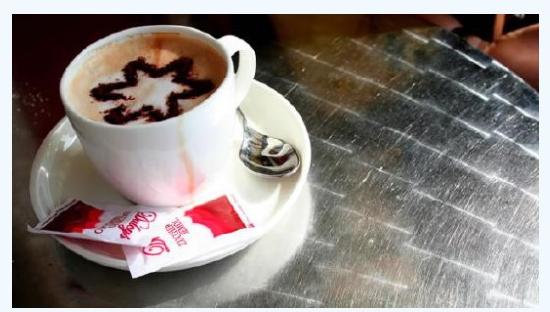
Psychoactive drugs are substances that change the function of the brain and result in alterations of mood, thinking, perception, and/or behavior. Psychoactive drugs may be used for many purposes, including therapeutic, ritual, or recreational purposes. Besides caffeine, other examples of psychoactive drugs include cocaine, LSD, alcohol, tobacco, codeine, and morphine. Psychoactive drugs may be legal prescription medications (e.g., codeine and morphine), legal nonprescription drugs (e.g., alcohol and tobacco), or illegal drugs (cocaine and LSD).

Cannabis (or marijuana) is also a psychoactive drug, but its status is in flux, at least in the United States. Depending on the jurisdiction, cannabis may be used recreationally and/or medically, and it may be either legal or illegal. Legal prescription medications such as opioids are also used illegally by increasingly large numbers of people. Some legal drugs, such as alcohol and nicotine, are readily available almost everywhere, as illustrated by the sign pictured in Figure \(\PageIndex{2}\).
Classes of Psychoactive Drugs
Psychoactive drugs are divided into different classes according to their pharmacological effects. Several classes are listed below, along with examples of commonly used drugs in each class.
- Stimulants are drugs that stimulate the brain and increase alertness and wakefulness. Examples of stimulants include caffeine, nicotine, cocaine, and amphetamines such as Adderall.
- Depressants are drugs that calm the brain, reduce anxious feelings, and induce sleepiness. Examples of depressants include ethanol (in alcoholic beverages) and opioids such as codeine and heroin.
- Anxiolytics are drugs that have a tranquilizing effect and inhibit anxiety. Examples of anxiolytic drugs include benzodiazepines such as diazepam (Valium), barbiturates such as phenobarbital, opioids, and antidepressant drugs such as sertraline (Zoloft).
- Euphoriants are drugs that bring about a state of euphoria, or intense feelings of well-being and happiness. Examples of euphoriants include the so-called club drug MDMA (ecstasy), amphetamines, ethanol, and opioids such as morphine.
- Hallucinogens are drugs that can cause hallucinations and other perceptual anomalies. They also cause subjective changes in thoughts, emotions, and consciousness. Examples of hallucinogens include LSD, mescaline, nitrous oxide, and psilocybin.
- Empathogens are drugs that produce feelings of empathy, or sympathy with other people. Examples of empathogens include amphetamines and MDMA.
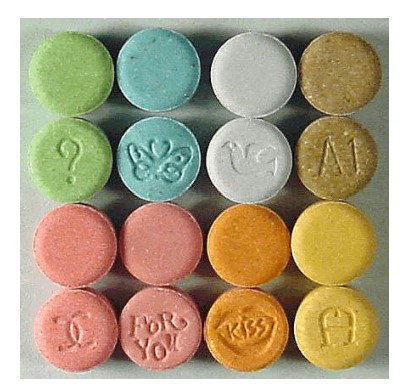
Many psychoactive drugs have multiple effects so they may be placed in more than one class. An example is MDMA, pictured below, which may act both as a euphoriant and as an empathogen. In some people, MDMA may also have stimulant or hallucinogenic effects. As of 2016, MDMA had no accepted medical uses, but it was undergoing testing for use in the treatment of post-traumatic stress disorder and certain other types of anxiety disorders.
Mechanisms of Action
Psychoactive drugs generally produce their effects by affecting brain chemistry, which in turn may cause changes in a person’s mood, thinking, perception, and/or behavior. Each drug tends to have a specific action on one or more neurotransmitters or neurotransmitter receptors in the brain. Generally, they act as either agonists or antagonists.
- Agonists are drugs that increase the activity of particular neurotransmitters. They might act by promoting the synthesis of the neurotransmitters, reducing their reuptake from synapses, or mimicking their action by binding to receptors for the neurotransmitters.
- Antagonists are drugs that decrease the activity of particular neurotransmitters. They might act by interfering with the synthesis of the neurotransmitters or by blocking their receptors so the neurotransmitters cannot bind to them.
Consider the example of the neurotransmitter GABA. This is one of the most common neurotransmitters in the brain, and it normally has an inhibitory effect on cells. GABA agonists, which increase its activity, include ethanol, barbiturates, and benzodiazepines, among other psychoactive drugs. All of these drugs work by promoting the activity of GABA receptors in the brain.
Chemistry of the Nervous System
Neurons, also called nerve cells, are electrically excitable cells that are the main functional units of the nervous system. Their function is to transmit nerve impulses. They are the only type of human cells that can carry out this function.
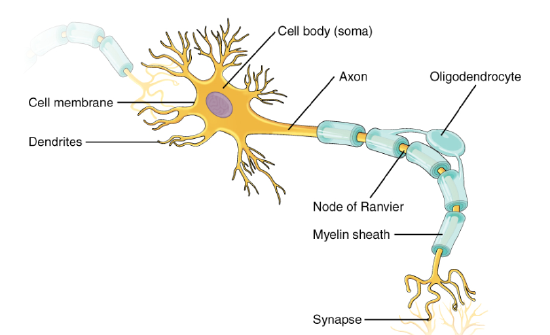
The main parts of a neuron are labeled in Figure \(\PageIndex{4}\) and described below.
- The cell body is the part of a neuron that contains the cell nucleus and other cell organelles. It is usually quite compact, and may not be much wider than the nucleus.
- Dendrites are thin structures that are extensions of the cell body. Their function is to receive nerve impulses from other cells and carry them to the cell body. A neuron may have many dendrites, and each dendrite may branch repeatedly to form a dendrite “tree” with more than 1,000 “branches.” The end of each branch can receive nerve impulses from another cell, allowing a given neuron to communicate with tens of thousands of other cells.
- The axon is a long, thin extension of the cell body. It transmits nerve impulses away from the cell body and toward other cells. The axon branches at the end, forming multiple axon terminals. These are the points where nerve impulses are transmitted to other cells, often to the dendrites of other neurons. An area called a synapse occurs at each axon terminal. Synapses are complex membrane junctions that transmit signals to other cells. An axon may branch hundreds of times, but there is never more than one axon per neuron.
- Spread out along axons, especially the long axons of nerves, are many sections of the myelin sheath. These are lipid layers that cover sections of the axon. The myelin sheath is a very good electrical insulator, similar to the plastic or rubber that encases an electrical cord.
- Regularly spaced gaps between sections of myelin sheath occur along the axon. These gaps are called nodes of Ranvier, and they allow the transmission of nerve impulses along the axon. Nerve impulses skip from node to node, allowing nerve impulses to travel along the axon very rapidly.
- A Schwann cell (also on an axon) is a type of glial cell. Its function is to produce the myelin sheath that insulates axons in the peripheral nervous system. In the central nervous system, a different type of glial cell, called an oligodendrocyte, produces the myelin sheath.
Neurotransmission is the process by which signaling molecules called neurotransmitters are released by the axon terminal of a neuron (the presynaptic neuron), and bind to and react with the receptors on the dendrites of another neuron (the postsynaptic neuron) a short distance away. Synapses are functional connections between neurons, or between neurons and other types of cells. The synaptic cleft —also called synaptic gap— is a gap between the pre- and postsynaptic cells that is about 20 nm (0.02 μ) wide. The small volume of the cleft allows neurotransmitter concentration to be raised and lowered rapidly.
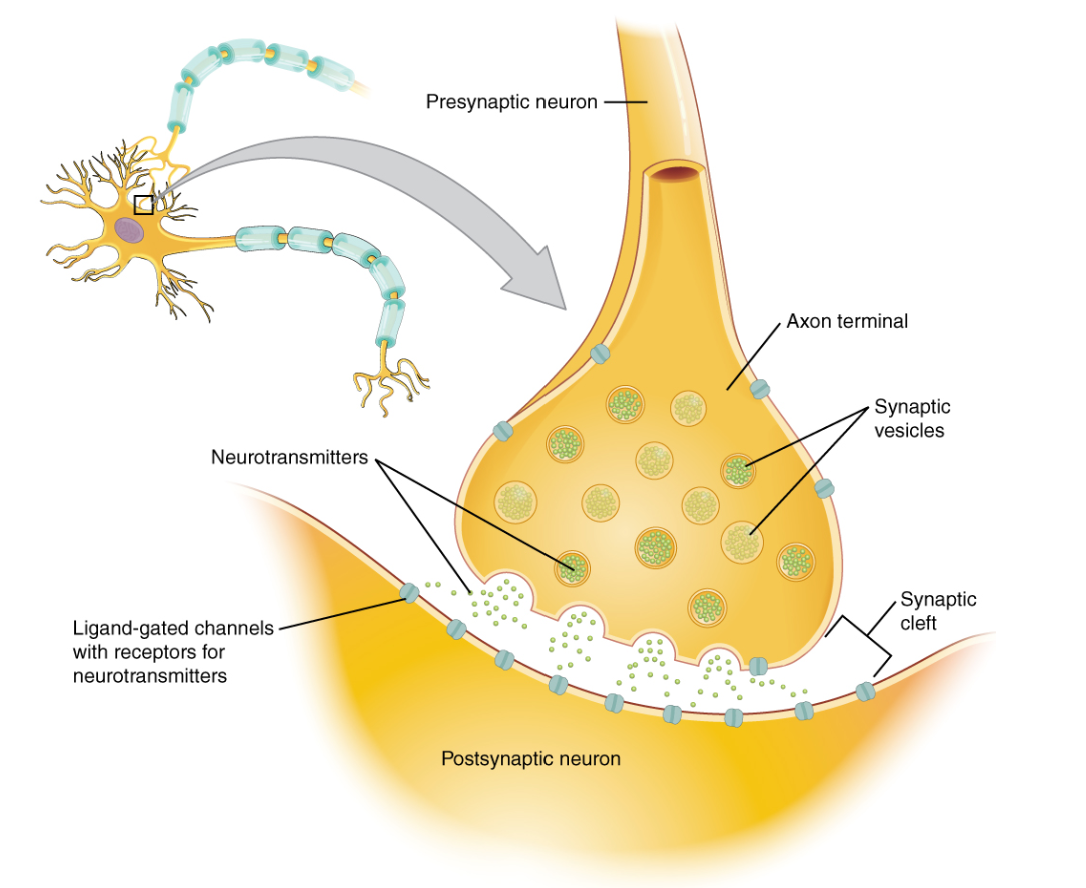
Neurotransmitters are endogenous chemicals that enable neurotransmission. It is a type of chemical messenger which transmits signals across a chemical synapse, such as a neuromuscular junction, from one neuron (nerve cell) to another "target" neuron, muscle cell, or gland cell.
Biochemical Theories of Brain Diseases
One theory that explains mental illness incorporates the various amounts of neurotransmitters. Using this theory, the lack or excess of specific neurotransmitters can be associated with depression, anxiety, bipolar disorder, or schizophrenia. Other disorders or health conditions, namely Attention Deficient Hyperactivity Disorder (ADHD) and Parkinson's Disease have also been linked with varying levels of neurotransmitters.
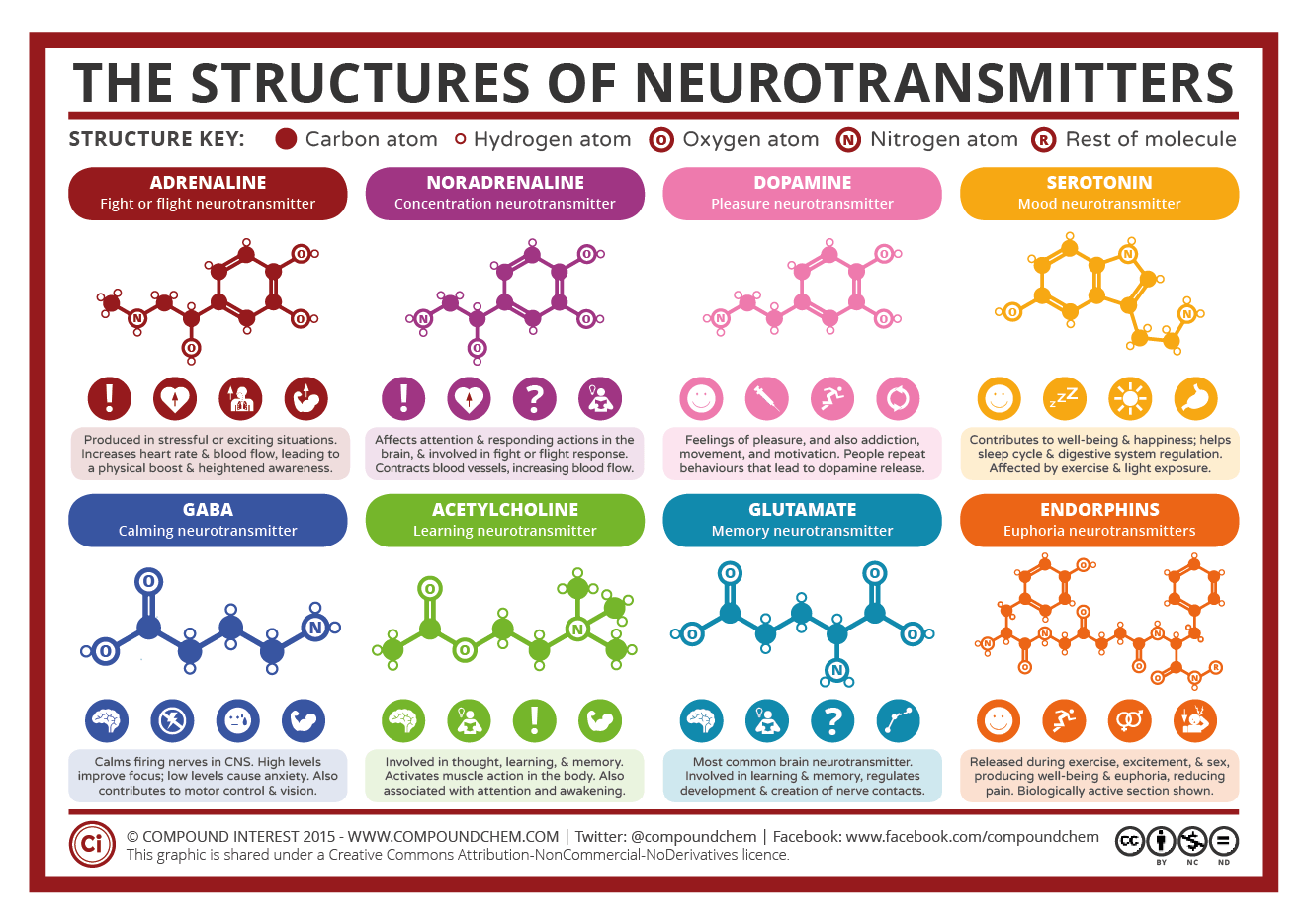
The Noradrenaline neurotransmitter is also called norepinephrine. When evaluating antidepressants or other mental health medications, it is important to be aware of this terminology. For a brief overview of the correlation between neurotransmitters and mental health, watch the video below.
Mental health conditions can result from a person's life experiences and/or genetics. Sometimes, drug usage or brain trauma can trigger mental illness. It is important to note all health conditions that are present in your family tree (biological). Also, recognizing emotional trauma and then seeking counseling/medical treatment is important for navigating a mental health condition.
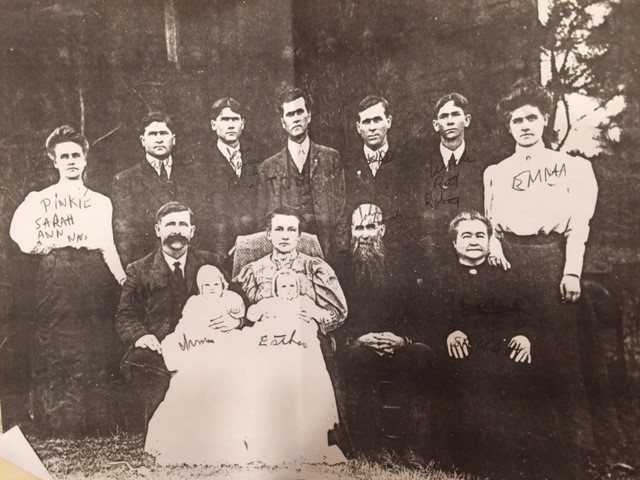
Depression symptoms
Can be short or long-term. Experience-sadness, sleeping and eating issues, withdrawal, feelings of hopelessness, loss of interest/pleasure, lack of energy, feelings of worthlessness/guilt, slowed processing, trouble concentrating, frequent thought of suicide/death, anxiety, and unexplained health problems.
Treatments for depression
psychotherapy, brain stimulation, medication, exercise, light therapy. Discussions to have with dr: meds/vitamins you are on, self-medication is not answer, stopping antidepressants without assistance, and report problems with meds. Limit alcohol and refrain from illicit and scheduled drugs. FDA black-box warning for antidepressants in people under 25.
Antidepressant Medications

Finding the correct antidepressant
Trial and Error-take for six weeks, then wean, and start another. Since the early 2000's, Mayo Clinic has been researching gene technology. Test is now offered by Assurex Health and called Genesight.
Common Side Effects of Antidepressants
This carry varies with the patient and type of medicine. Most common include weight gain, fatigue, dizziness, loss of sexual desire, nausea, dry mouth, blurred vision, agitation, insomnia, and constipation.
Support and information regarding mental health conditions.
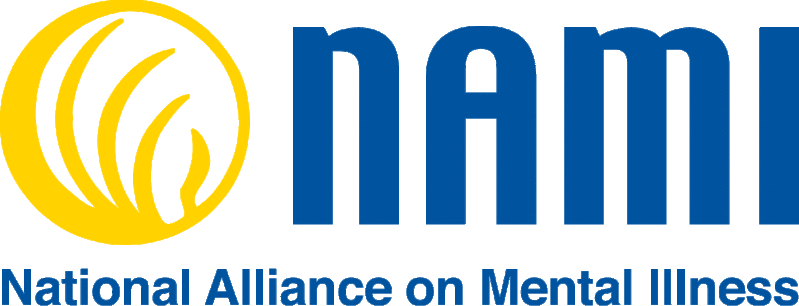
Anesthetics
An anesthetic or anaesthetic is a drug used to induce anesthesia - in other words, to result in a temporary loss of sensation or awareness. They may be divided into two broad classes: general anesthetics, which result in a reversible loss of consciousness, and local anesthetics, which cause a reversible loss of sensation for a limited region of the body without necessarily affecting consciousness.
A wide variety of drugs are used in modern anesthetic practice. Many are rarely used outside anesthesiology, but others are used commonly in various fields of healthcare. Combinations of anesthetics are sometimes used for their synergistic and additive therapeutic effects. Adverse effects, however, may also be increased. Anesthetics are distinct from analgesics, which block only sensation of painful stimuli.
General Anesthetics
General anesthetics are often defined as compounds that induce a loss of consciousness in humans or loss of righting reflex in animals. Clinical definitions are also extended to include the lack of awareness to painful stimuli, sufficient to facilitate surgical applications in clinical and veterinary practice. General anesthetics do not act as analgesics and should also not be confused with sedatives. General anesthetics are a structurally diverse group of compounds whose mechanisms encompasses multiple biological targets involved in the control of neuronal pathways. The precise workings are the subject of some debate and ongoing research.
General anesthetics elicit a state of general anesthesia. It remains somewhat controversial regarding how this state should be defined. General anesthetics, however, typically elicit several key reversible effects: immobility, analgesia, amnesia, unconsciousness, and reduced autonomic responsiveness to noxious stimuli.
Mode of administration
Drugs given to induce general anesthesia can be either as gases or vapors (inhalational anesthetics), or as injections (intravenous anesthetics or even intramuscular). All of these agents share the property of being quite hydrophobic (i.e., as liquids, they are not freely miscible—or mixable—in water, and as gases they dissolve in oils better than in water). It is possible to deliver anesthesia solely by inhalation or injection, but most commonly the two forms are combined, with an injection given to induce anesthesia and a gas used to maintain it.
Inhalation
General anesthetics are frequently administered as volatile liquids or gases (Figure \(\PageIndex{6}\)). Inhalational anesthetic substances are either volatile liquids or gases, and are usually delivered using an anesthesia machine. An anesthesia machine allows composing a mixture of oxygen, anesthetics and ambient air, delivering it to the patient and monitoring patient and machine parameters. Liquid anesthetics are vaporized in the machine.
Many compounds have been used for inhalation anesthesia, but only a few are still in widespread use. Desflurane, isoflurane and sevoflurane are the most widely used volatile anesthetics today. They are often combined with nitrous oxide. Older, less popular, volatile anesthetics, include halothane, enflurane, and methoxyflurane. Researchers are also actively exploring the use of xenon as an anesthetic.

Injection
Injectable anesthetics are used for the induction and maintenance of a state of unconsciousness. Anesthetists prefer to use intravenous injections, as they are faster, generally less painful and more reliable than intramuscular or subcutaneous injections. Among the most widely used drugs are propofol, etomidate, barbiturates such as methohexital and thiopentone/thiopenta, Benzodiazepines such as midazolam, Ketamine is used in the UK as "field anaesthesia", for instance in road traffic incidents or similar situations where an operation must be conducted at the scene or when there is not enough time to move to an operating room, while preferring other anesthetics where conditions allow their use. It is more frequently used in the operative setting in the US. Benzodiazepines are sedatives and are used in combinations with other general anesthetics.
Local Anesthetics
The first local anesthetic to be discovered was cocaine, an alkaloid contained in large amounts in the leaves of Erythroxylon coca, a shrub growing in the Andes Mountains. Over 9 million kilograms of these leaves are consumed annually by the 2 million inhabitants of the highlands of Peru, who chew or suck the leaves for the sense of wellbeing it produces.
Local anesthetics are drugs that block nerve conduction when applied locally to nerve conduction when applied locally to nerve tissue in appropriate concentrations. They act on any part of the nervous system and on every type of nerve fiber. For example, when they are applied to the motor cortex impulse transmission from that area stops, and when they are injected into the skin they prevent the initiation and the transmission of sensory impulses. A local anesthetic in contact with a nerve trunk can cause both sensory and motor paralysis in the area innervated. The great practical advantage of the local anesthetic is that their action is reversible: their use is followed by complete recovery in nerve function with no evidence of structural damage to nerve fibers of cells.
The structures some of the typical anesthetics are shown below.

These structures contain hydrophilic and hydrophobic domains that are separated by an intermediate alkyl chain. Linkage of these two domains is of either the ester or amide type. the ester link is important because this bond is readily hydrolyzed during metabolic degradation and inactivation in the body. Procaine, for example, can be divided into three main portions: the aromatic acid (para-aminobenzoic), the alcohol (ethanol), and the tertiary amino group (diethylamino). Changes in any part of the molecule alter the anesthetic potency and the toxicity of the compound. Increasing the length of the alcohol group leads to a greater anesthetic potency. It also leads to an increase in toxicity.
Depressants
A depressant, or central depressant, is a drug that lowers neurotransmission levels, which is to depress or reduce arousal or stimulation, in various areas of the brain. Depressants are also occasionally referred to as "downers" as they lower the level of arousal when taken. Stimulants or "uppers" increase mental and/or physical function, hence the opposite drug class of depressants is stimulants, not antidepressants.
Depressants are widely used throughout the world as prescription medicines and as illicit substances. When depressants are used, effects often include ataxia, anxiolysis, pain relief, sedation or somnolence, and cognitive/memory impairment, as well as in some instances euphoria, dissociation, muscle relaxation, lowered blood pressure or heart rate, respiratory depression, and anticonvulsant effects. Depressants also act to produce anesthesia. Cannabis may sometimes be considered a depressant due to one of its components, cannabidiol. The latter is known to treat insomnia, anxiety and muscle spasms similar to other depressive drugs. However, tetrahydrocannabinol, another component, may slow brain function to a small degree while reducing reaction to stimuli, it is generally considered to be a stimulant and main psychoactive agent to sometimes cause anxiety, panic and psychosis instead. Other depressants can include drugs like Xanax (a benzodiazepine) and a number of opiates.
Depressants exert their effects through a number of different pharmacological mechanisms, the most prominent of which include facilitation of GABA, and inhibition of glutamatergic or monoaminergic activity. Other examples are chemicals that modify the electrical signaling inside the body, the most prominent of these being bromides and body blockers.
Alcohol
Alcohol is a very prominent depressant. Alcohol can be and is more likely to be a large problem among teenagers and young adults. Symptoms of alcohol consumption at lower doses may include mild sedation and poor coordination. At higher doses, there may be slurred speech, trouble walking, and vomiting. Extreme doses may result in a respiratory depression, coma, or death. Complications may include seizures, aspiration pneumonia, injuries including suicide, and low blood sugar. Alcohol intoxication can lead to alcohol-related crime with perpetrators more likely to be intoxicated than victims.
Alcohol intoxication typically begins after two or more alcoholic drinks. Risk factors include a social situation where heavy drinking is common and a person having an impulsive personality. Diagnosis is usually based on the history of events and physical examination. Verification of events by witnesses may be useful. Legally, alcohol intoxication is often defined as a blood alcohol concentration (BAC) of greater than 5.4–17.4 mmol/L (25–80 mg/dL or 0.025–0.080%). This can be measured by blood or breath testing. Alcohol is broken down in human body at a rate of about 3.3 mmol/L (15 mg/dL) per hour.
Alcohol intoxication is very common, especially in the Western world. Most people who drink alcohol have at some time been intoxicated. In the United States acute intoxication directly results in about 2,200 deaths per year, and indirectly more than 30,000 deaths per year. Acute intoxication has been documented throughout history and alcohol remains one of the world's most widespread recreational drugs. Some religions consider alcohol intoxication to be a sin.
Barbiturates
Barbiturates are CNS depressants and are similar, in many ways, to the depressant effects of alcohol. To date, there are about 2,500 derivatives of barbituric acid of which only 15 are used medically. The first barbiturate was synthesized from barbituric acid in 1864.
The original use of barbiturates was to replace drugs such as opiates, bromides, and alcohol to induce sleep. Barbiturates are effective as anxiolytics, hypnotics, and anticonvulsants, but have physical and psychological addiction potential as well as overdose potential among other possible adverse effects. They have largely been replaced by benzodiazepines (discussed below) and nonbenzodiazepines ("Z-drugs") in routine medical practice, particularly in the treatment of anxiety and insomnia, due to the significantly lower risk of addiction and overdose and the lack of an antidote for barbiturate overdose. Despite this, barbiturates are still in use for various purposes: in general anesthesia, epilepsy, treatment of acute migraines or cluster headaches, euthanasia, capital punishment, and assisted suicide.
![barbituates[1].gif](https://chem.libretexts.org/@api/deki/files/125061/barbituates%255B1%255D.gif?revision=1)
Some symptoms of an overdose typically include sluggishness, incoordination, difficulty in thinking, slowness of speech, faulty judgement, drowsiness, shallow breathing, staggering, and, in severe cases, coma or death. The lethal dosage of barbiturates varies greatly with tolerance and from one individual to another.
Barbiturates in overdose with other CNS (central nervous system) depressants (e.g. alcohol, opiates, benzodiazepines) are even more dangerous due to additive CNS and respiratory depressant effects. In the case of benzodiazepines, not only do they have additive effects, barbiturates also increase the binding affinity of the benzodiazepine binding site, leading to exaggerated benzodiazepine effects. (ex. If a benzodiazepine increases the frequency of channel opening by 300%, and a barbiturate increases the duration of their opening by 300%, then the combined effects of the drugs increase the channels overall function by 900%, not 600%).
Anti-anxiety Agents
Anti-anxiety medications help reduce the symptoms of anxiety, such as panic attacks, or extreme fear and worry.
Benzodiazepines are prescribed to quell panic attacks. Benzodiazepines are also prescribed in tandem with an antidepressant for the latent period of efficacy associated with many antidepressants for anxiety disorder. The effects of the benzodiazepines virtually all result from action of these drugs on the central nervous system, even when lethal doses are used. The most prominent of these effects are sedation, hypnosis, decreased anxiety, muscle relaxation, and anticonvulsant activity. As the dose of a benzodiazepine is increased, sedation progresses to hypnosis and hypnosis to stupor. They are used as sedatives, hypnotics, antianxiety agents (in panic disorder), anticonvulsants, muscle relaxants, in anesthesia and in alcoholism.
There is risk of benzodiazepine withdrawal and rebound syndrome if BZDs are rapidly discontinued. Tolerance and dependence may occur. The risk of abuse in this class of medication is smaller than in that of barbiturates. Cognitive and behavioral adverse effects are possible.
There are several useful benzodiazepines available. The skeletal structure and two examples are shown below.
![benzodiazepines[1].gif](https://chem.libretexts.org/@api/deki/files/125059/benzodiazepines%255B1%255D.gif?revision=1)
Benzodiazepine include: Alprazolam (Xanax), Bromazepam, Chlordiazepoxide (Librium), Clonazepam (Klonopin), Diazepam (Valium), Lorazepam (Ativan), Oxazepam, Temazepam, and Triazolam. Short half-life (or short-acting) benzodiazepines (such as Lorazepam) and beta-blockers are used to treat the short-term symptoms of anxiety. Beta-blockers help manage physical symptoms of anxiety, such as trembling, rapid heartbeat, and sweating that people with phobias (an overwhelming and unreasonable fear of an object or situation, such as public speaking) experience in difficult situations. Taking these medications for a short period of time can help the person keep physical symptoms under control and can be used “as needed” to reduce acute anxiety.
Antipsychotics, also known as neuroleptics, are a class of psychotropic medication primarily used to manage psychosis (including delusions, hallucinations, paranoia or disordered thought), principally in schizophrenia but also in a range of other psychotic disorders. They are also the mainstay together with mood stabilizers in the treatment of bipolar disorder.
The phenothiazines as a class, and especially chlorpromazine, the prototype, are among the most widely used drugs in medical practice and are primarily employed in the management of patients with serious psychiatric illnesses. In addition, many members of the group have other clinically useful properties, including antiemetic, antinausea, and antihistaminic effects and the ability to potentiate analgesics, sedatives and general anesthetics.
It was noted that chlorpromazine by itself did not cause a loss of consciousness but produced only a tendency to sleep and a lack of interest in what was going on. These central actions became known as neuroleptic soon after.
Phenothiazine has a tricyclic structure in which two benzene rings are linked by a sulfur and a nitrogen atom (see figures below). Substitution of an electron-withdrawing group at R2 (but not at position 3 or 4) increases the efficacy of phenothiazines and other tricyclic congeners.
![phenothiazines[1].gif](https://chem.libretexts.org/@api/deki/files/125062/phenothiazines%255B1%255D.gif?revision=1)
Neuroleptic drugs reduce initiative and interest in the environment, and they reduce displays of emotion or affect. Initially there may be some slowness in response to external stimuli and drowsiness. However subject are easily aroused, capable of giving appropriate answers to direct questions, and seem to have intact intellectual functions; there is no ataxia, incoordination, or dysathria at ordinary doses. Psychotic patients become less agitated and restless, and withdrawn or autistic patients sometimes become more responsive and communicative. Aggressive and impulsive behavior diminishes. Gradually (over a period of days). psychotic symptoms of hallucinations, delusions, and disorganized or incoherent thinking tend to disappear.
The most prominent observable effects of typical neuroleptic agents are strikingly similar. In low doses, operant behavior is reduced but spinal reflexes are unchanged. Exploratory behavior is diminished, and responses to a a variety of stimuli are fewer, slower, and smaller, although the ability to discriminate stimuli is retained. Conditioned avoidance behaviors are selectively inhibited, while unconditioned escape or avoidance responses are not.
In 1994 an addition tot he antipsychotic drugs is risperidone (Risperdal). This drug antagonises D2 and serotonin type 2 receptors. The drug also antagonizes for other receptors such as a adrenergic and histaminergic H1 receptors.
![risperdone[1].gif](https://chem.libretexts.org/@api/deki/files/125063/risperdone%255B1%255D.gif?revision=1)
Anti Depressants
Major depression is the most common of the major mental illnesses, and it must be distinguished from normal grief, sadness, and disappointment. Major depression is characterized by feelings of intense sadness and despair, mental slowing and loss of concentration, pessimistic worry, agitation, and self-depreciation. Physical changes also occur, such as weight loss, decreased libido, and disruption of hormonal circadian rhythms.
Before the advent of psychotherapy in the 1950s, treatment of depression consisted of stimulants such as caffeine and amphetamines to ameliorate the depressive phases and barbiturates to allay agitation, anxiety, and insomnia. At best, such attempts at therapy may have offered transient relief to some patients. Suffering usually decreased little.
Monoamine Oxidase Inhibitors
Monoamine oxidase inhibitors (MAOIs) were the first effective antidepressants used. The monoamine oxidase inhibitors comprise a chemically heterogeneous group of drugs that have in common the ability to block oxidative deamination of naturally occurring monoamines. These drugs have numerous other effects, many of which are still poorly understood. For example, they lower blood pressure and were at one time used to treat hypertension. Their use in psychiatry has also become very limited as the tricyclic antidepressants have come to dominate the treatment of depression and allied conditions. Thus, MAOIs are used most often when tricyclic antidepressants give unsatisfactory results. In addition, whereas severe depression may not be the primary indication for these agents, certain neurotic illnesses with depressive features, and also with anxiety and phobias, may respond especially favorably.
Serotonin
Serotonin (5-hydroxytryptamine or 5-HT) is a monoamine neurotransmitter found in cardiovascular tissue, in endothelial cells, in blood cells, and in the central nervous system. The role of serotonin in neurological function is diverse, and there is little doubt that serotonin is an important CNS neurotransmitter.
![serotonin[1].gif](https://chem.libretexts.org/@api/deki/files/125064/serotonin%255B1%255D.gif?revision=1)
The monoamine serotonin is itself a precursor for melatonin production in the pineal gland. The biosynthesis of serotonin from the amino acid tryptophan is similar to that found for the catecholamines, and 5-hydroxytryptophan can cross the BBB to increase central levels of 5-HT. Although some of the serotonin is metabolized by monoamine oxidase to 5-hydroxyindole acetic acid, most of the serotonin released into the post-synaptic space is removed by the neuron through a reuptake mechanism inhibited by the tricyclic antidepressants and the newer, more selective antidepressants such as fluoxetine and sertraline.
Serotonin receptors are diverse and numerous. Over the past several years, over fourteen different serotonin receptors have been cloned and sequenced through molecular biological techniques. Overall, there are seven distinct families of 5-HT receptors, with as many as five within a particular family. Only one of the 5-HT receptors is a ligand-gated ion channel (the 5-HT3 receptor), and the other six families are all G protein-coupled receptors.
Tricyclic Anti-depressants
Imipramine, amitriptylin, and other closely related drugs are among the drugs currently most widely used for the treatment of major depression. Because of there structure ( see below). They are often referred to as the tricyclic antidepressants. Although these compounds seem to be similar to the phenothiazines chemically, the ethylene group of imiprimine's middle ring imparts dissimilar stereochemical properties and prevents conjegation of the rings, as occurs with the phenothiazines.
![tricyclic[1].gif](https://chem.libretexts.org/@api/deki/files/125065/tricyclic%255B1%255D.gif?revision=1)
One might expect an effective antidepressant drug to have a stimulating or mood-elevating effect when given to a normal subject. Although this may occur with the MAOIs, it is not true of the tricyclic antidepressants. If a dose of imipramine given to a normal subject, he feels sleepy and tends to be quieter, his blood pressure falls slightly, and he feels light headed. These drug effects are usually perceived to be unpleasant, and cause a feeling of unhappiness and increased anxiety. Repeated administration for several days may lead to accentuation of these symptoms and, in addition, to difficulty in concentrating and thinking. In contrast, if the drug is given over a period of time ( two to three weeks) to depressed patients an elevated mood occurs. For this reason, the tricyclics are not prescribed on an "as-needed" basis.
Selective Serotonin Reuptake Inhibitors
In recent years, selective serotonin reuptake inhibitors (SSRIs) have been introduced for the treatment of depression. Prozac is the most famous drug in this class. Lilly's sales of Prozac in 1993 exceeded 1 billion US dollars. Clomiprimine, fluoxetine (Prozac), sertraline and paroxetine selectively block the reuptake of serotonin, thereby increasing the levels of serotonin in the central nervous system. Note the similarities and differences between the tricyclic antidepressants and the selective serotonin reuptake inhibitors. The SSRIs generally have fewer anticholinergic side effects, but caution is still necessary when co-administering any drugs that affect serotonergic systems (e.g., monoamine oxidase inhibitors). Some of the newer, SSRIs (e.g., clomipramine) have been useful in the treatment of obsessive-compulsive disorders.
![prozac[1].gif](https://chem.libretexts.org/@api/deki/files/125066/prozac%255B1%255D.gif?revision=1)
Stimulants
These classes of chemicals induce alertness and stimulant the brain and nervous system. Side effects of stimulant use include wakefulness, increased speech, and motor activity, and decreased appetite. Amphetamines are a type of stimulant that incorporates a nitrogen-containing organic functional group. These compounds have been noted to block the reuptake of dopamine.
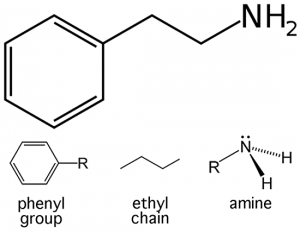
Early Stimulant Use
For over 5000 years, the Chinese have extracted the compound Ephedrine from locally grown Ephedra plants. Native peoples of the United States were known to isolate this compound as well. Both cultures used Ephedrine to treat asthma, hay fever, and congestion. Ephedrine was noted to have a stimulant effect on its users. Chemically similar to adrenaline, ephedrine was a more stable compound and could be taken orally. By the mid-1920s, the pharmaceutical company, Eli Lily, synthesized ephedrine and introduced it into western medicine.
Figure \(\PageIndex{14}\): : https://commons.wikimedia.org/wiki/C...phedra_viridis. (Copyright, https://commons.wikimedia.org/wiki/User:Dcrjsr)
Ephedrine can decrease appetite, increase blood pressure and heart rate, and cause sleeping problems. Mental health can be affected by ephedrine use. Patients may experience hallucinogens, anxiety, and chemical dependence.
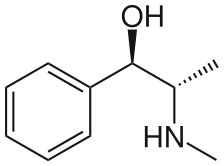
Amphetamine is a potent central nervous system (CNS) stimulant of the phenethylamine class that is approved for the treatment of attention deficit hyperactivity disorder (ADHD) and narcolepsy. Amphetamine is also used off-label as a performance and cognitive enhancer, and recreationally as an aphrodisiac and euphoriant. Although it is a prescription medication in many countries, unauthorized possession and distribution of amphetamine is often tightly controlled due to the significant health risks associated with uncontrolled or heavy use. As a consequence, amphetamine is illegally manufactured in clandestine labs to be trafficked and sold to users. Based upon drug and drug precursor seizures worldwide, illicit amphetamine production and trafficking is much less prevalent than that of methamphetamine.
The first pharmaceutical amphetamine was Benzedrine, a brand of inhalers used to treat a variety of conditions. At therapeutic doses, this drug causes emotional and cognitive effects such as euphoria, change in libido, increased arousal, and improved cognitive control. Likewise, it induces physical effects such as decreased reaction time, fatigue resistance, and increased muscle strength. In contrast, supratherapeutic doses of amphetamine are likely to impair cognitive function and induce rapid muscle breakdown. Very high doses can result in psychosis (e.g., delusions and paranoia), which very rarely occurs at therapeutic doses even during long-term use. As recreational doses are generally much larger than prescribed therapeutic doses, recreational use carries a far greater risk of serious side effects, such as dependence, which only rarely arises with therapeutic amphetamine use.
3,4-Methylenedioxymethamphetamine (MDMA, ecstasy, or molly) is a euphoriant, empathogen, and stimulant of the amphetamine class. Briefly used by some psychotherapists as an adjunct to therapy, the drug became popular recreationally and the DEA listed MDMA as a Schedule I controlled substance, prohibiting most medical studies and applications. MDMA is known for its entactogenic properties. The stimulant effects of MDMA include hypertension, anorexia (appetite loss), euphoria, social disinhibition, insomnia (enhanced wakefulness/inability to sleep), improved energy, increased arousal, and increased perspiration, among others. Relative to catecholaminergic transmission, MDMA enhances serotonergic transmission significantly more, when compared to classical stimulants like amphetamine. MDMA does not appear to be significantly addictive or dependence forming.
Methylenedioxypyrovalerone (MDPV) is a psychoactive drug with stimulant properties that acts as a norepinephrine-dopamine reuptake inhibitor (NDRI). It was first developed in the 1960s by a team at Boehringer Ingelheim. MDPV remained an obscure stimulant until around 2004, when it was reported to be sold as a designer drug. Products labeled as bath salts containing MDPV were previously sold as recreational drugs in gas stations and convenience stores in the United States, similar to the marketing for Spice and K2 as incense.
Incidents of psychological and physical harm have been attributed to MDPV use.
Mephedrone is a synthetic stimulant drug of the amphetamine and cathinone classes. Slang names include drone and MCAT. It is reported to be manufactured in China and is chemically similar to the cathinone compounds found in the khat plant of eastern Africa. It comes in the form of tablets or a powder, which users can swallow, snort, or inject, producing similar effects to MDMA, amphetamines, and cocaine.
Methamphetamine (contracted from N-methyl-alpha-methylphenethylamine) is a potent psychostimulant that is used to treat attention deficit hyperactivity disorder (ADHD) and obesity. Recreationally, methamphetamine is used to increase sexual desire, lift the mood, and increase energy, allowing some users to engage in sexual activity continuously for several days straight.
In low doses, methamphetamine can cause an elevated mood and increase alertness, concentration, and energy in fatigued individuals. At higher doses, it can induce psychosis, rhabdomyolysis, and cerebral hemorrhage. Methamphetamine is known to have a high potential for abuse and addiction. Recreational use of methamphetamine may result in psychosis or lead to post-withdrawal syndrome, a withdrawal syndrome that can persist for months beyond the typical withdrawal period. Unlike amphetamine and cocaine, methamphetamine is neurotoxic to humans, damaging both dopamine and serotonin neurons in the central nervous system (CNS). Entirely opposite to the long-term use of amphetamine, there is evidence that methamphetamine causes brain damage from long-term use in humans; this damage includes adverse changes in brain structure and function, such as reductions in gray matter volume in several brain regions and adverse changes in markers of metabolic integrity.
Methylphenidate is a stimulant drug that is often used in the treatment of ADHD and narcolepsy and occasionally to treat obesity in combination with diet restraints and exercise. Its effects at therapeutic doses include increased focus, increased alertness, decreased appetite, decreased need for sleep and decreased impulsivity. Methylphenidate is not usually used recreationally, but when it is used, its effects are very similar to those of amphetamines.
Methylphenidate is sold under a number of brand names including Ritalin. Other versions include the long lasting tablet Concerta and the long lasting transdermal patch Daytrana.
Phenylpropanolamine (PPA; Accutrim; β-hydroxyamphetamine), also known as norephedrine and norpseudoephedrine, is a psychoactive drug that is used as a stimulant, decongestant, and anorectic agent. It is commonly used in prescription and over-the-counter cough and cold preparations. In veterinary medicine, it is used to control urinary incontinence in dogs under trade names Propalin and Proin.
In the United States, PPA is no longer sold without a prescription due to a proposed increased risk of stroke in younger women. In a few countries in Europe, however, it is still available either by prescription or sometimes over-the-counter.
Propylhexedrine (Hexahydromethamphetamine, Obesin) is a stimulant medication, sold over-the-counter in the United States as the cold medication Benzedrex. The drug has also been used as an appetite suppressant in Europe. Propylhexedrine is not an amphetamine, though it is structurally similar; it is instead a cycloalkylamine, and thus has stimulant effects that are less potent than similarly structured amphetamines, such as methamphetamine.
The abuse potential of propylhexedrine is fairly limited, due its limited routes of administration: in the United States, Benzedrex is only available as an inhalant, mixed with lavender oil and menthol. These ingredients cause unpleasant tastes, and abusers of the drug have reported unpleasant "menthol burps". Injection of the drug has been found to cause transient diplopia and brain stem dysfunction.
Pseudoephedrine is used as a nasal/sinus decongestant, as a stimulant, or as a wakefulness-promoting agent. The salts pseudoephedrine hydrochloride and pseudoephedrine sulfate are found in many over-the-counter preparations, either as a single ingredient or (more commonly) in combination with antihistamines, guaifenesin, dextromethorphan, and/or paracetamol (acetaminophen) or another NSAID (such as aspirin or ibuprofen). It is also used as a precursor chemical in the illegal production of methamphetamine.

Cocaine, Caffeine, and Nicotine
Cocaine is a tropane alkaloid and stimulant drug obtained primarily from the leaves of two coca species, Erythroxylum coca and Erythroxylum novogranatense. It is most commonly used as a recreational drug and euphoriant. After extraction from coca leaves, cocaine may be snorted, heated until sublimated and then inhaled, or dissolved and injected into a vein. Mental effects may include an intense feeling of happiness, sexual arousal, loss of contact with reality, or agitation. Physical symptoms may include a fast heart rate, sweating, and dilated pupils. High doses can result in high blood pressure or body temperature. Effects begin within seconds to minutes of use and last between five and ninety minutes.
Cocaine is addictive due to its effect on the reward pathway in the brain. A single dose of cocaine induces tolerance to the drug's effects. After a short period of use, addiction is likely. Abstention from cocaine after chronic use results in drug withdrawal, with symptoms that may include depression, decreased ability to feel pleasure and subjective fatigue. Cocaine's use increases the overall risk of death and particularly the risk of trauma, and infectious diseases, such as blood infections and AIDS. It also increases risk of stroke, heart attack, cardiac arrhythmia, lung injury (when smoked), and sudden cardiac death. Illicitly-sold cocaine is commonly adulterated with local anesthetics, levamisole, cornstarch, quinine, or sugar, which can result in additional toxicity. The Global Burden of Disease study found that cocaine use caused the death of 7.3 people per 100,000 population world-wide.
Caffeine is a central nervous system (CNS) stimulant of the methylxanthine class. It is the world's most widely consumed psychoactive drug. Unlike many other psychoactive substances, it is legal and unregulated in nearly all parts of the world. There are several known mechanisms of action to explain the effects of caffeine. The most prominent is that it reversibly blocks the action of adenosine on its receptors and consequently prevents the onset of drowsiness induced by adenosine. Caffeine also stimulates certain portions of the autonomic nervous system.
Methyxanthines such as caffeine, theophylline and theobromine share in common several pharmacological actions of therapeutic interest. They stimulate the central nervous system, act on the kidney to produce diuresis, stimulate cardiac muscle, and relax smooth muscle, notably bronchial muscle. Because the various xanthines differ markedly in the intensity of their action on various structures, one particular xanthine has been used more than another for a particular therapeutic effect. Since theobromine displays low potency in these pharmacological actions, it has all but disappeared from the therapeutic scene.
Caffeine, theophyline, and theobromine occur naturally in plants widely distributed geographically. Caffeine is found in the coffee bean, tea leaves, guarana, and other plants. From the figure below, we can see that the methylxanthines have a structure which is very similar to adenine.
![cafeine[1].gif](https://chem.libretexts.org/@api/deki/files/125067/cafeine%255B1%255D.gif?revision=1)
| Beverage/Food | Milligrams |
|---|---|
| Starbuck’s Grande Coffee (16 oz.) | 380 |
| Plain brewed coffee (8 oz.) | 102–200 |
| Espresso (1 oz.) | 30–90 |
| Plain, decaffeinated coffee (8 oz.) | 3–12 |
| Tea, brewed (8 oz.) | 40–120 |
| Green tea (8 oz.) | 25–40 |
| Coca-Cola Classic (12 oz.) | 35 |
| Dr. Pepper (12 oz.) | 44 |
| Jolt Cola (12 oz.) | 72 |
| Mountain Dew (12 oz.) | 54 |
| Mountain Dew, MDX (12 oz.) | 71 |
| Pepsi-Cola (12 oz.) | 38 |
| Red Bull (8.5 oz.) | 80 |
| Full Throttle (16 oz.) | 144 |
| Monster Energy (16 oz.) | 160 |
| Spike Shooter (8.4 oz.) | 300 |
Source: MedicineNet.com. “Caffeine.” Accessed October 2, 2011. http://www.medicinenet.com/caffeine/article.htm.
Health Benefits of Caffeine
The most renowned effects of caffeine on the body are increased alertness and delay of fatigue and sleep. How does caffeine stimulate the brain? Watch "Video 15.6.1" to see a graphic account of a brain on caffeine. Caffeine is chemically similar to a chemical in our brains (adenosine). Caffeine interacts with adenosine’s specific protein receptor. It blocks the actions of the adenosine, and affects the levels of signaling molecules in the brain, leading to an increase in energy metabolism. At the molecular level, caffeine stimulates the brain, increasing alertness and causing a delay of fatigue and sleep. At high doses caffeine stimulates the motor cortex of the brain and interferes with the sleep-wake cycle, causing side effects such as shakiness, anxiety, and insomnia. People’s sensitivity to the adverse effects of caffeine varies and some people develop side effects at much lower doses. The many effects caffeine has on the brain do not diminish with habitual drinking of caffeinated beverages.
Video 15.6.1: A Brain on Caffeine. Watch this graphic account of the brain on caffeine.
Scientific studies suggest caffeine can improve endurance capacity by increasing energy available during exercise. The effect may only work in non-caffeine drinkers and it only takes 1-3 days for the body to become "caffeine-naive."
Nicotine is the active chemical constituent in tobacco, which is available in many forms, including cigarettes, cigars, chewing tobacco, and smoking cessation aids such as nicotine patches, nicotine gum, and electronic cigarettes. Nicotine is used widely throughout the world for its stimulating and relaxing effects. Nicotine exerts its effects through the agonism of nicotinic acetylcholine receptor, resulting in multiple downstream effects such as increase in activity of dopaminergic neurons in the midbrain reward system, as well as the decreased expression of monoamine oxidase in the brain. Nicotine is addictive and dependence forming.
The information below is directly from the link below
https://d14rmgtrwzf5a.cloudfront.net/sites/default/files/hallucinogensrrs4.pdf
Hallucinogens are a class of drugs that cause hallucinations—profound distortions in a person’s perceptions of reality. Hallucinogens can be found in some plants and mushrooms (or their extracts) or can be man-made, and they are commonly divided into two broad categories: classic hallucinogens (such as LSD) and dissociative drugs (such as PCP). When under the influence of either type of drug, people often report rapid, intense emotional swings and seeing images, hearing sounds, and feeling sensations that seem real but are not. While the exact mechanisms by which hallucinogens and dissociative drugs cause their effects are not yet clearly understood, research suggests that they work at least partially by temporarily disrupting communication between neurotransmitter systems throughout the brain and spinal cord that regulate mood, sensory perception, sleep, hunger, body temperature, sexual behavior, and muscle control.

Classic Hallucinogens
LSD (d-lysergic acid diethylamide)—also known as acid, blotter, doses, hits, microdots, sugar cubes, trips, tabs, or window panes—is one of the most potent moodand perception-altering hallucinogenic drugs. It is a clear or white, odorless, water-soluble material synthesized from lysergic acid, a compound derived from a rye fungus. LSD is initially produced in crystalline form, which can then be used to produce tablets known as “microdots” or thin squares of gelatin called “window panes.” It can also be diluted with water or alcohol and sold in liquid form. The most common form, however, is LSD-soaked paper punched into small individual squares, known as “blotters.”
Psilocybin (4-phosphoryloxyN, N-dimethyltryptamine)—also known as magic mushrooms, shrooms, boomers, or little smoke—is extracted from certain types of mushrooms found in tropical and subtropical regions of South America, Mexico, and the United States. In the past, psilocybin was ingested during religious ceremonies by indigenous cultures from Mexico and Central America. Psilocybin can either be dried or fresh and eaten raw, mixed with food, or brewed into a tea, and produces similar effects to LSD.
Peyote (Mescaline)— also known as buttons, cactus, and mesc— is a small, spineless cactus with mescaline as its main ingredient. It has been used by natives in northern Mexico and the southwestern United States as a part of religious ceremonies. The top, or “crown,” of the peyote cactus has disc-shaped buttons that are cut out, dried, and usually chewed or soaked in water to produce an intoxicating liquid. Because the extract is so bitter, some users prepare a tea by boiling the plant for several hours. Mescaline can also be produced through chemical synthesis.
DMT (Dimethyltryptamine)—also known as Dimitri—is a powerful hallucinogenic chemical found naturally occurring in some Amazonian plant species (see “Ayahuasca”) and also synthesized in the laboratory. Synthetic DMT usually takes the form of a white crystalline powder and is typically vaporized or smoked in a pipe. Ayahuasca—also known as hoasca, aya, and yagé—is a hallucinogenic brew made from one of several Amazonian plants containing DMT (the primary psychoactive ingredient) along with a vine containing a natural alkaloid that prevents the normal breakdown of DMT in the digestive tract. Ayahuasca tea has traditionally been used for healing and religious purposes in indigenous South American cultures, mainly in the Amazon region.
Dissociative Drugs
PCP (Phencyclidine)—also known as ozone, rocket fuel, love boat, hog, embalming fluid, or superweed—was originally developed in the 1950s as a general anesthetic for surgery. While it can be found in a variety of forms, including tablets or capsules, it is usually sold as a liquid or powder. PCP can be snorted, smoked, injected, or swallowed. It is sometimes smoked after being sprinkled on marijuana, tobacco, or parsley.
Ketamine—also known as K, Special K, or cat Valium—is a dissociative currently used as an anesthetic for humans as well as animals. Much of the ketamine sold on the street has been diverted from veterinary offices. Although it is manufactured as an injectable liquid, ketamine is generally evaporated to form a powder that is snorted or compressed into pills for illicit use. Because ketamine is odorless and tasteless and has amnesia-inducing properties, it is sometimes added to drinks to facilitate sexual assault. 2 NIDA Research Report Series Common Hallucinogens and Dissociative Drugs *In this report, the term “hallucinogen” will refer to the classic hallucinogenic drugs LSD and Psilocybin.
DXM (Dextromethorphan)— also known as robo—is a cough suppressant and expectorant ingredient in some over-the-counter (OTC) cold and cough medications that are often abused by adolescents and young adults. The most common sources of abused DXM are “extra-strength” cough syrup, which typically contains around 15 milligrams of DXM per teaspoon, and pills and gel capsules, which typically contain 15 milligrams of DXM per pill. OTC medications that contain DXM often also contain antihistamines and decongestants.
Salvia divinorum—also known as diviner’s sage, Maria Pastora, Sally-D, or magic mint—is a psychoactive plant common to southern Mexico and Central and South America. Salvia is typically ingested by chewing fresh leaves or by drinking their extracted juices. The dried leaves of salvia can also be smoked or vaporized and inhaled.
Short-Term General Effects of Hallucinogens Sensory and Physical Effects
• Hallucinations, including seeing, hearing, touching, or smelling things in a distorted way or perceiving things that do not exist
• Intensified feelings and sensory experiences (brighter colors, sharper sounds)
• Mixed senses (“seeing” sounds or “hearing” colors)
• Changes in sense or perception of time (time goes by slowly) Physical Effects
• Increased energy and heart rate
• Nausea
Marijuana
The information below is directly from the link below
https://medlineplus.gov/marijuana.html
Marijuana is a green, brown, or gray mix of dried, crumbled parts from the marijuana plant. The plant contains chemicals which act on your brain and can change your mood or consciousness.
Marijuana can cause both short-term and long-term effects.
| Short term: | Long term: |
|
While you are high, you may experience
|
In the long term, marijuana can cause health problems, such as
|
Medical Marijuana
The marijuana plant has chemicals that can help with some health problems. More states are making it legal to use the plant as medicine for certain medical conditions. But there isn't enough research to show that the whole plant works to treat or cure these conditions. The U.S. Food and Drug Administration (FDA) has not approved the marijuana plant as a medicine. Marijuana is still illegal at the national level.
However, there have been scientific studies of cannabinoids, the chemicals in marijuana. The two main cannabinoids that are of medical interest are THC and CBD. The FDA has approved two drugs that contain THC. These drugs treat nausea caused by chemotherapy and increase appetite in patients who have severe weight loss from AIDS. There is also a liquid drug that contains CBD. It treats two forms of severe childhood epilepsy. Scientists are doing more research with marijuana and its ingredients to treat many diseases and conditions.
Summary
- Neurotransmitters are endogenous chemicals that enable neurotransmission. It is a type of chemical messenger which transmits signals across a chemical synapse, such as a neuromuscular junction, from one neuron (nerve cell) to another "target" neuron, muscle cell, or gland cell.
- Strong imbalances or disruptions to neurotransmitter systems have been associated with many diseases and mental disorders.
- Psychoactive drugs are substances that change the function of the brain and result in alterations of mood, thinking, perception, and/or behavior. They include prescription medications such as opioid painkillers, legal substances such as nicotine and alcohol, and illegal drugs such as LSD and heroin.
- Psychoactive drugs are divided into different classes according to their pharmacological effects. They include stimulants, depressants, anxiolytics, euphoriants, hallucinogens, and empathogens. Many psychoactive drugs have multiple effects so they may be placed in more than one class.
- Psychoactive drugs generally produce their effects by affecting brain chemistry. Generally, they act either as agonists, which enhance the activity of particular neurotransmitters; or as antagonists, which decrease the activity of particular neurotransmitters.
- Psychoactive drugs are used for various purposes, including medical, ritual, and recreational purposes.
- Misuse of psychoactive drugs may lead to addiction, which is compulsive use of a drug despite negative consequences such use may entail. Sustained use of an addictive drug may produce physical or psychological dependence on the drug. Rehabilitation typically involves psychotherapy and sometimes the temporary use of other psychoactive drugs.
Contributors
- Libretext: Human Biology (Wakim and Grewal)
- Charles Ophardt, Professor Emeritus, Elmhurst College; Virtual Chembook
- NIH National Institute of Mental Health
- NIH National Institute on Drug Abuse
- NIH-Medlineplus
- Psychology OPENSTAX
- Wikipedia

